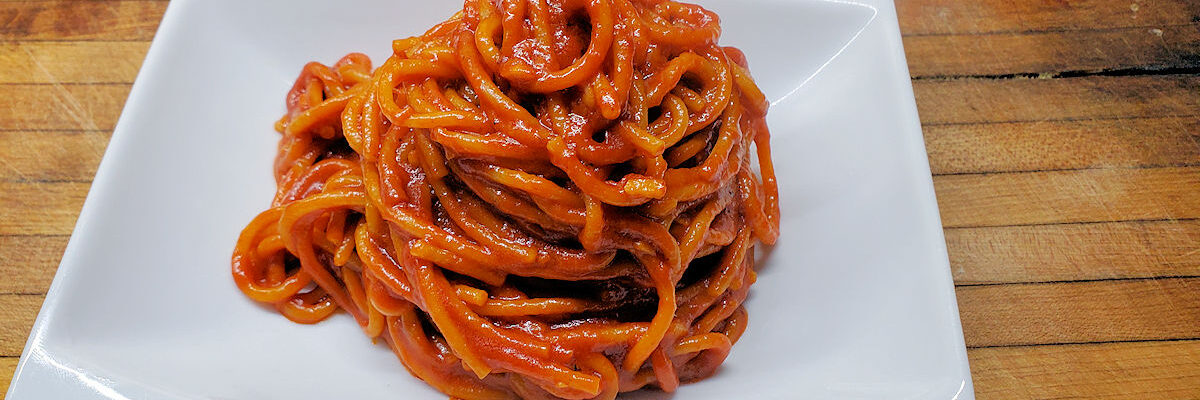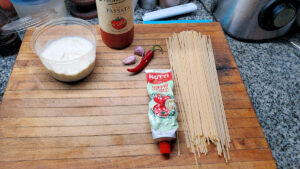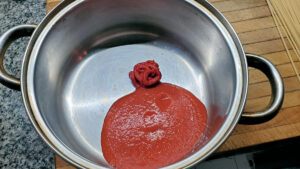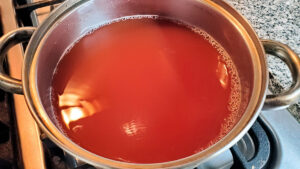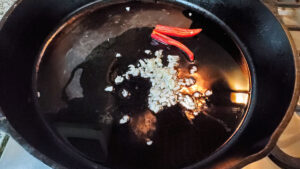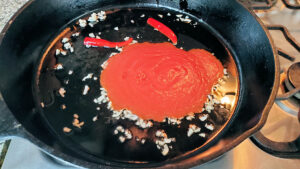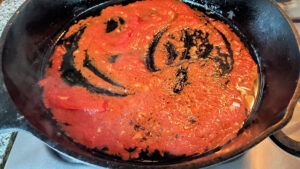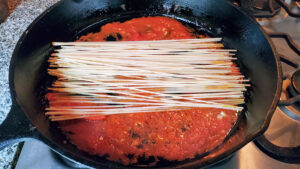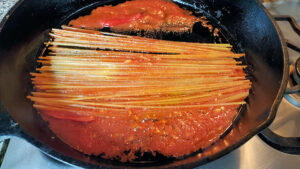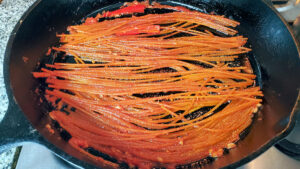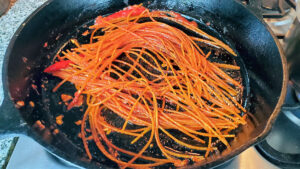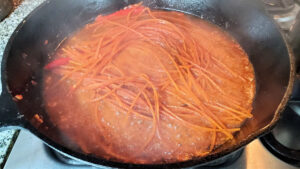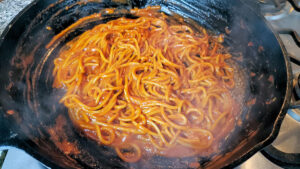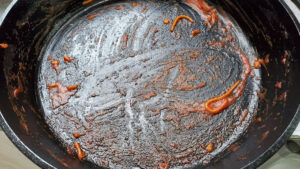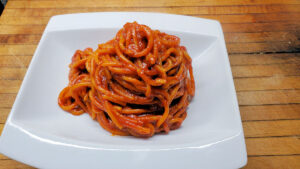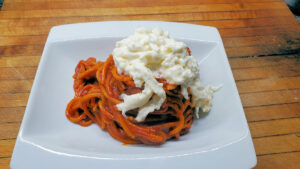As with so many of these origin stories, we have some facts and we have some speculation. Let’s contrast… the recipe came to fame at one of two restaurants in the town of Bari, in Apulia, Italy – Marc’Aurelio or Al Sorso Preferito. The generally accepted one is the latter, and chef Enzo Francavilla is credited with “the invention” in the late 1960s, just over fifty years ago. However, it may well be that he simply codified a recipe that was already common in the area, and gave it a name… Spaghetti all’Assassina, or “Assassin’s Spaghetti”. There’s a fair amount of anecdotal evidence that it was already a known recipe in the area, though at the same time, no one has produced an older written recipe, nor evidence of it being on the menu at other restaurants in the region prior to that time.
The meaning of the name is up for some debate, with some claiming it’s a reference to the intense spiciness of the dish, others that it was a compliment to the chef, like “wow, that’s a killer dish”, and others, and probably most common, that it’s a reference to the cooking method – of almost ruthless treatment of the pasta. And, of course, the last has been taken as a mantra by some out there on the ‘net as license to practically burn the pasta to a crisp and claim that that’s the real way to cook it. There is, however, an academy dedicated to this pasta, because in Italy, of course there’s an academy dedicated to yet one more specific dish. I imagine some guy sitting at a desk fielding that once a month phone call, email, or letter from some distant cook demanding to know the true secret. They don’t tell you to burn the pasta to a crisp.
One of the theories of prior origin to the restaurant above is that it was a way to re-cook leftover pasta in tomato sauce – throw it in a pan with some oil and reheat it, lightly frying the pasta at the same time. And the first person who showed me this recipe actually followed that – taking already cooked spaghetti in tomato sauce, frying it until lightly golden, and throwing in some chilies, more garlic, and some cherry tomatoes. For a long time I thought this was the real recipe. It was a mess to make, because already cooked spaghetti in a frying pan has a tendency to stick. It was still a good dish, but nothing like the one I had when I finally tried and learned how to make the real thing.
This recipe has basically six ingredients. Dry spaghetti, tomato paste, chili, garlic, tomato passata, and olive oil. Water and salt too if you want to get picky. I’ve also included straciatella cheese in the photo because while not part of the original recipe, it’s a common addition at the end – Italians, like many others, like cheese. Straciatella is basically the innards of a burrata – shredded fresh mozzarella and cream. There are also some other variations on the dish that are common – straciatella and broccoli rabe, seafood, and a sweet green olive version are among the most common recognized variations. But we’ll focus on the basic, original one today.
You also need the right kind of pan. It works best in a large cast iron skillet that’s well seasoned, because, well, you’ll see.
Take some of the passata and some tomato paste and dissolve it in water. Lightly season with salt. Really not much at all, because this is going to get very concentrated. Some people wait until the end to add salt, but that just puts the salt into the final sauce, and it doesn’t get absorbed into the pasta itself. Here I’ve got maybe a liter and a half of “broth” and I put in about a quarter teaspoon of salt. Put this pot over a low flame and get it almost to the point of simmering. Basically, we’re about to make our pasta in the same approach we’d take to make a risotto.
Over low flame, heat up your cast iron skillet for a few minutes. You can actually start this before you make the broth, because the broth will have plenty of time to heat up. Once the pan is nice and hot add a generous amount of olive oil, and add in the chopped garlic, and just split open the chili. Up to you how spicy you want this, you can remove the seeds or not. I did, because this chili was really fiery. Some people chop up the chili along with the garlic, but my understanding is that’s not traditional – it’s going to be removed later. Dried chili flakes? You can, but again, apparently not traditional.
After a minute, add in a good dollop of the passata.
Cook that, basically frying it in the oil, until it becomes a fairly thick paste.
Add your dry spaghetti and flip it around until it’s well coated with the sauce and oil.
Continue cooking it over low heat for about 15-20 minutes. I tend to flip it roughly once every minute. That allows it to gradually absorb all the sauce in the pan and begin to fry. Now, here’s where people either get timid or aggressive. You really do want the pasta to fry, to be somewhat ruthless about it. You want it to get to the point where the pasta is actually getting golden brown on its surface. On the other hand, unlike some of the YouTube videos out there I’ve seen, you do not want this to get dark brown and crunchy, or actually burn. It’s a balancing act, and to some extent, personal tastes down the line. I could probably have carried this a few minutes more without crossing into the too far territory, but this is roughly where I like it – if you click on the second photo you can see the surface of the spaghetti is getting browned.
And, now we start the second cooking process, treating this spagetti like we would a risotto. A ladle at a time, add the tomato broth to the skillet, letting the pasta cook slowly. Each time, let the liquid almost completely absorb and evaporate prior to adding the next ladle. This will take about the same time as making a risotto – so it’s more time than you’d normally cook the spaghetti. Chalk that up to the cooking method being slower than boiling it as well as the slower absorption by the pasta because of the browning on the surface. Figure on another 15-20 minutes until the pasta is at a classic al dente stage.
When it reaches that point, remove the chili and finish cooking it until it’s basically aborbed all the sauce. You basically want it to start sizzling in the remaining oil, which is my sign that it’s done. When you remove it from the skillet you should be left with basically nothing. This is also the point to give a quick taste and see if it needs more salt. It probably won’t.
And, serve. Really classically, unadorned by anything else. And it’s really good this way.
I also like it with a bit of the straciatella over the top – it gives it an added level of richness. It does, admittedly, tone down the spiciness a little bit – though I tend not to mix in the cheese, but just grab a bit on the fork along with some of the pasta – giving a bit of contrast.
With so few ingredients, you’d think this pasta wouldn’t be overly complex in flavor, but all those toasty, fried notes, the richness of both tomato paste and passata, and the garlic and chili, result in a surprisingly complex dish. No question it’s a bit tedious to make, but it’s worth every minute.
